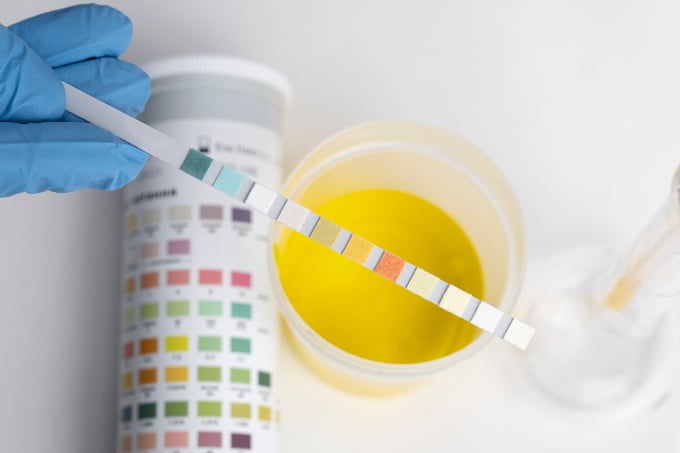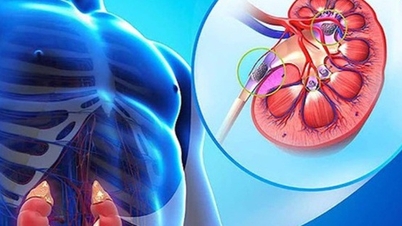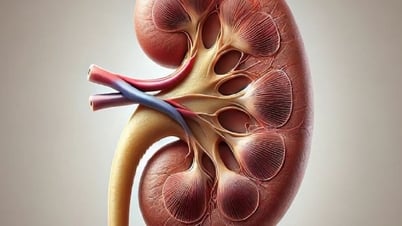Urine test results are the basis for detecting some dangerous diseases such as kidney stones, glomerulonephritis, kidney failure... along with other diagnostic methods.
Urine tests show the presence and concentration of substances in urine. Dr. Mai Thi Hien (Deputy Head of the Department of Urology - Andrology and Nephrology, Tam Anh General Hospital , Hanoi ) said that based on the results of urine tests, doctors can detect signs of kidney disease or pathogens. At the same time, this test is also valuable in monitoring and evaluating the effectiveness of treatment methods as well as the health status of the patient.
Urine test indicators include protein concentration, pH or acid level in urine, red blood cells... when there are abnormalities, they can help detect kidney diseases such as kidney stones, kidney failure, nephritis...
Kidney stones
Kidney stones are the most common disease of the urinary tract. In Vietnam, about 10-14% of people have kidney stones. The disease is common in people aged 30 to 55, with more men than women. The common types are calcium stones, oxalate stones and struvite stones. Urine test results help doctors make conclusions about the condition, stages and complications of kidney stones, especially urinary tract infections.
According to Dr. Hien, from a urine sample, doctors can examine the sediment to find crystals such as oxalate, phosphate, calcium... to conclude what type of stones are forming in the urinary tract. If the pH level in the urine is greater than 6.5, the patient may have a urinary tract infection.
In cases of kidney stones with complications of infection, urine tests often find many red blood cells and white blood cells. If urine tests detect more protein in the urine than normal, the doctor will have to diagnose additional glomerular diseases.

Urine test indicators can help detect kidney diseases. Photo: Freepik
Glomerulonephritis
Inflammation that occurs in the glomeruli and blood vessels in the kidneys is called glomerulonephritis. The disease can occur at any age with many causes. If not detected and treated promptly, the disease can cause serious health effects, even death.
Dr. Hien said that if the test shows a higher level of protein in the urine, the prognosis is worse. If the protein returns negative, it means the disease is cured. If the urine test shows positive signs of hematuria, the risk of glomerulonephritis still recurs.

Dr. Mai Thi Hien is examining a patient. Photo: Tam Anh General Hospital
Acute pyelonephritis
This is a bacterial urinary tract infection that can be cured if treated early. However, if detected and treated late or treated improperly, the disease is likely to recur and can lead to complications such as kidney failure, kidney pus, renal papillary necrosis, sepsis, ... and even death.
Patients with acute pyelonephritis often have fever, chills, and flank pain. Urine tests show pus cells, many red blood cells, and white blood cells. Urinary stones that are not treated promptly are a favorable factor for acute pyelonephritis.
Nephrotic syndrome
A condition of kidney dysfunction that causes the body to excrete too much protein in the urine is called nephrotic syndrome. The disease causes swelling of the whole body, weight gain, and little urine.
Damage to the glomerular filtration membrane causes protein to leak into the urine. High proteinuria causes cloudy, foamy urine, and some patients urinate less than normal during the illness. Urine tests reveal birefringent fat granules and fat casts.
Kidney failure
This is a condition where the kidneys lose their function and are no longer able to filter and remove toxins from the blood. Patients need dialysis or a kidney transplant to stay alive.
To assess the condition and response to treatment, the doctor will measure the amount of urine excreted by the body over a period of time. If the amount of urine decreases below 0.5 ml/kg/hour for 6 hours despite adequate fluid replacement, the patient is at risk of acute kidney failure; 0.5 ml/kg/hour for 12 hours is acute kidney injury; below 0.3 ml/kg/hour for 24 hours, or anuria for more than 12 hours is a sign of acute kidney failure.
Dr. Hien added that if microscopic blood is detected in the urine, the patient may have acute kidney failure due to kidney damage or urinary tract obstruction.
Trinh Mai
Source link







































![[Photo] Nearly 104,000 candidates in Hanoi complete procedures to take the 10th grade entrance exam](https://vphoto.vietnam.vn/thumb/1200x675/vietnam/resource/IMAGE/2025/6/7/7dbf58fd77224eb583ea5c819ebf5a4e)



























































![[OCOP REVIEW] Tu Duyen Syrup - The essence of herbs from the mountains and forests of Nhu Thanh](https://vphoto.vietnam.vn/thumb/402x226/vietnam/resource/IMAGE/2025/6/5/58ca32fce4ec44039e444fbfae7e75ec)







Comment (0)